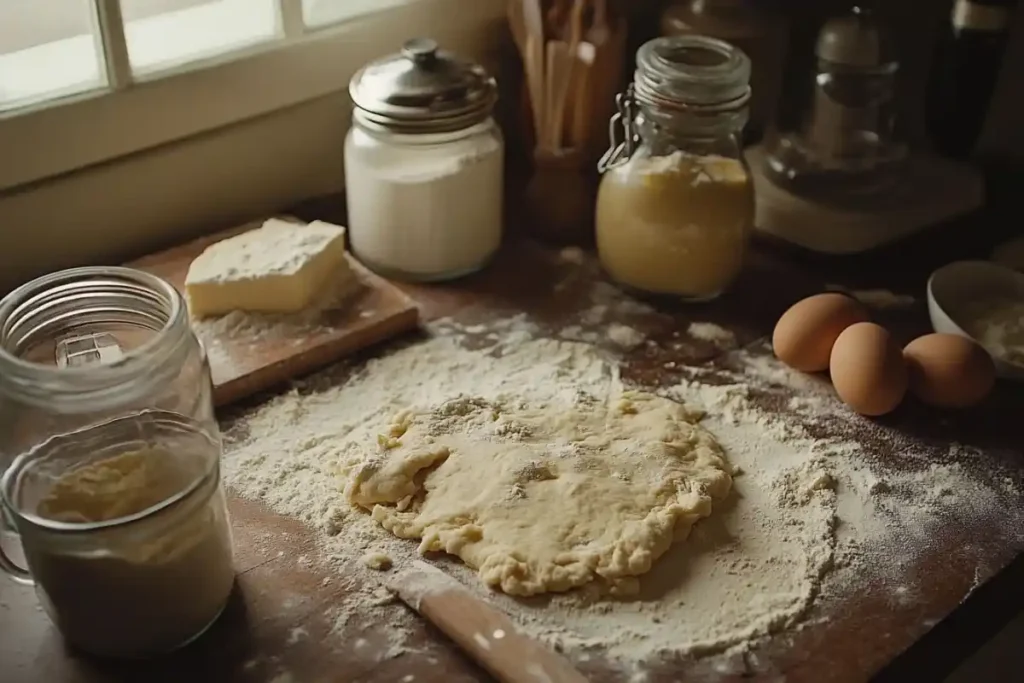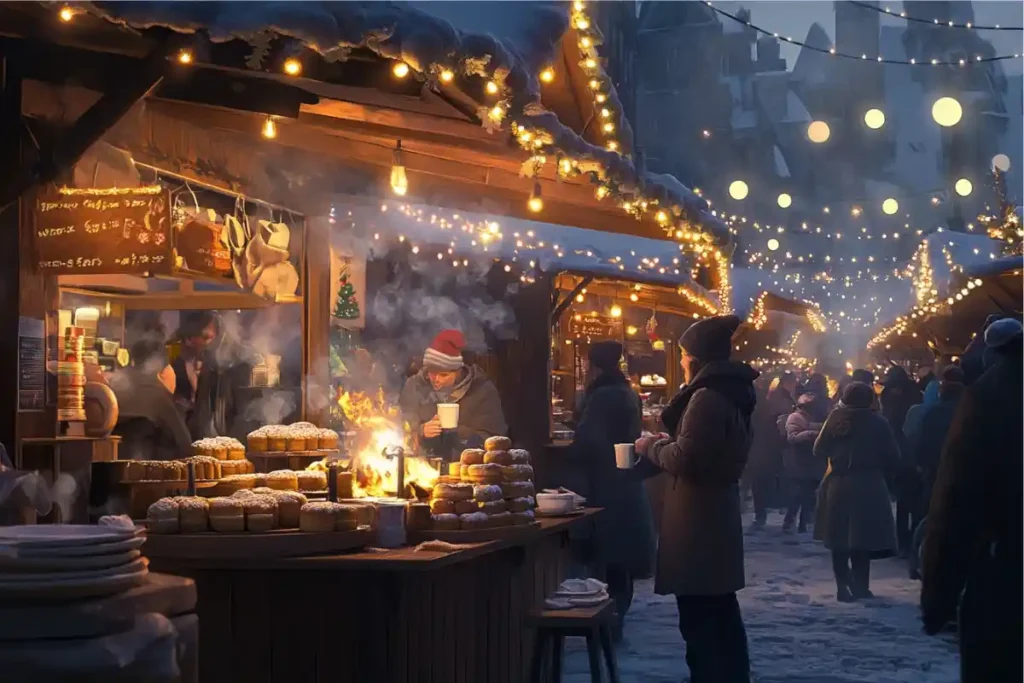Introduction
Have you ever wondered what chimney cake is made of and why people across Europe love it so much? This delicious treat began as a traditional Hungarian street food and quickly won hearts around the globe. In addition, this article will uncover its simple yet irresistible ingredients, explain how bakers craft its signature shape, and explore the toppings that make every bite a delight. Whether you’re a foodie, a traveler, or a home baker, you’re about to embark on a sweet journey—pun intended!
Introduction to Chimney Cake
What is Chimney Cake?
Chimney cake, or Kürtőskalács in Hungary, stands out with its sweet, hollow pastry design. Bakers stretch yeast dough into a long strip, wrap it around a cylinder, roll it in sugar, and bake it until the crust turns golden and caramelized. As a result, the pastry develops its iconic texture and flavor. Meanwhile, steam escapes from the hollow center, creating a chimney-like effect that inspired its name. Its caramelized sugar coating and soft interior offer a delightful combination of textures and flavors.
Historical Origins of Chimney Cake
Chimney cakes emerged in the 15th century in Hungary and Transylvania, where families baked them to celebrate festive occasions. Over time, as the recipe gained popularity, vendors began selling them at street markets and festivals, spreading their reputation across Europe. Consequently, chimney cakes became a cherished symbol of tradition and indulgence. Today, chimney cakes connect people to their cultural roots while offering a timeless indulgence.
Why the Name “Chimney Cake”?
The name reflects its unique appearance. For instance, steam rises from the hollow center as the cake bakes, imitating the smoke that streams out of a chimney. Combined with its cylindrical shape, this visual makes the name a perfect fit. Thus, the dessert earned its charming title.
Core Ingredients of Chimney Cake
Main Dough Components

Chimney cake starts with a simple yet delicious sweet yeast dough. Bakers mix flour, sugar, yeast, eggs, and butter to create a rich and pliable dough that holds its shape during baking. The flour provides structure, and the sugar caramelizes beautifully while adding sweetness. Butter enhances the dough’s softness and flavor, making each bite irresistible.
Yeast plays a key role by helping the dough rise and creating a light, airy texture. As bakers knead and shape the dough, the ingredients combine to form the foundation of a perfect chimney cake. For extra flavor, many bakers add vanilla or lemon zest to give the dough a subtle aromatic twist.
If you’re curious about other dough-based recipes, check out How to Make Sourdough Garlic Bread.
Optional Flavor Enhancements
Bakers often enhance the chimney cake’s flavor by adding delicious extras. Common choices include:
- Vanilla extract to introduce a sweet and fragrant aroma.
- Cinnamon for a warm, spicy kick that complements the sugary crust.
- Lemon or orange zest to brighten the flavor with citrusy freshness.
These additions allow bakers to customize the chimney cake without straying far from its traditional roots.
So, what is chimney cake made of? The answer isn’t just the ingredients—it’s the creativity and care that bakers bring to every recipe.
Preparation Techniques and Cooking Process
Shaping the Dough
Bakers begin by rolling the yeast dough into long, thin strips. They then wrap the strips around a cylindrical mold, carefully layering them for a uniform spiral shape. This iconic design allows the chimney cake to cook evenly. After wrapping, bakers coat the dough with granulated sugar, which caramelizes during baking to create a crisp, golden crust.
If you want to try making chimney cake but don’t have a mold, use oven-safe items like a rolling pin or a soda can wrapped in foil. This creative hack lets you recreate chimney cakes at home.
For more creative uses of dough, explore Cottage Cheese Flatbread Recipes.
Baking and Caramelization
Bakers traditionally roast chimney cakes over an open flame to give the dessert a subtle smoky flavor. Modern kitchens, however, rely on ovens or grills to achieve similar results. To ensure even browning, bakers rotate the mold continuously during the baking process.
As the sugar caramelizes, it forms a shiny, crunchy coating that locks in the dough’s moisture. Once the chimney cakes finish baking, bakers often dust them with cinnamon or top them with crushed nuts for added flavor and texture.
So, what is chimney cake made of? It’s not just dough and sugar—it’s also the skillful preparation and baking techniques that bring this unique dessert to life.
Popular Variations and Toppings
Classic Variations
Chimney cake comes in many variations, but the classics always hold a special place. Bakers traditionally roll the dough in granulated sugar before baking, which caramelizes into a sweet, golden crust. For a timeless twist, they often add cinnamon, creating a warm and spicy flavor that perfectly complements the sugary coating.
Another popular option includes crushed walnuts. Bakers press these nuts onto the sugar-coated dough before baking, giving the cake a satisfying crunch and nutty taste. These toppings enhance the chimney cake without overshadowing its iconic base, making them favorites among purists.
If you love sweet treats with a twist, consider exploring other recipes like White Chocolate Bread Pudding for more indulgent ideas.
Modern Twists
Modern bakers love experimenting with chimney cakes, taking their creativity to the next level. Some dip the finished cakes in melted chocolate or drizzle them with Nutella for a decadent touch. Others fill the hollow center with soft-serve ice cream, whipped cream, or fruit, transforming the treat into a stunning dessert centerpiece.
For adventurous flavor combinations, try adding shredded coconut, colorful sprinkles, or even crushed candy bars to the caramelized crust. These updates make chimney cakes a hit at parties and festivals, offering a fun twist on a timeless dessert.
So, what is chimney cake made of? The answer lies not only in its basic ingredients but also in the endless possibilities for toppings and fillings that allow everyone to enjoy it their way.
Cultural and Culinary Significance
Street Food Delight in Hungary and Beyond

Chimney cake holds a cherished place in Hungarian street food culture. Vendors prepare them fresh at markets and festivals, filling the air with the irresistible aroma of caramelized sugar. Locals and tourists alike enjoy the experience of watching bakers skillfully roast the cakes over an open flame before savoring the warm, crispy, and soft treat.
Over time, chimney cakes have crossed borders, becoming a popular dessert at international fairs and Christmas markets. They symbolize Hungary’s culinary heritage while delighting new fans across the globe.
Festivals and Celebrations Featuring Chimney Cake
In Hungary, chimney cakes often take center stage during holidays and festivals. Families bake them during special occasions to celebrate traditions and share sweet moments. Their festive appearance and customizable flavors make them perfect for gatherings.
Today, chimney cakes also shine in modern celebrations. Weddings, birthdays, and even food festivals feature these treats, showcasing their versatility and universal appeal. Whether served plain or with extravagant toppings, chimney cakes continue to bring people together.
For more recipes that are perfect for celebrations, check out our other guides on delicious party desserts.
FAQs on Chimney Cake
What Makes Chimney Cake Unique?
Chimney cake stands out because of its distinctive preparation and appearance. Bakers wrap the dough in a spiral around a cylindrical mold and bake it until golden brown. As it bakes, the dough releases steam through its hollow center, resembling a chimney. The caramelized sugar crust adds a delightful crunch, while the soft interior creates a perfect balance of textures.
When you ask what is chimney cake made of, the answer goes beyond its simple ingredients. The artistry and creativity behind its preparation make it a unique and cherished treat.
Can You Make Chimney Cake at Home?
Yes, you can! While traditional chimney cakes are roasted over an open flame, modern kitchens allow you to bake them in the oven or grill them on a barbecue. You can even improvise with items like soda cans wrapped in foil as molds.
Homemade chimney cakes let you experiment with flavors and toppings, making them a fun and rewarding project for bakers of all skill levels.
What Are Some Popular Chimney Cake Flavors?
Classic chimney cakes often feature toppings like cinnamon, walnuts, or vanilla sugar. However, modern versions include chocolate dips, sprinkles, or even ice cream fillings. These creative twists make chimney cakes endlessly versatile and perfect for any occasion.
Conclusion
Wrapping It Up
Chimney cakes offer a perfect blend of tradition and innovation. From their humble beginnings as Hungarian street food to their global popularity today, these sweet pastries have captured the hearts of food lovers everywhere. But what is chimney cake made of? It’s more than just yeast dough and sugar—it’s a combination of heritage, skill, and imagination.
Whether you enjoy them plain, coated in cinnamon, or filled with ice cream, chimney cakes bring joy with every bite. Their versatility makes them perfect for festivals, parties, or simply treating yourself to something special.
So, why not try making chimney cake at home? With a bit of creativity and the right toppings, you can recreate this iconic dessert and share its magic with family and friends. For more ideas and inspiration, check out other delicious recipes to elevate your baking game.
Health Considerations of Chimney Cake
Nutritional Breakdown
Chimney cake, while indulgent, is surprisingly simple in its composition. What is chimney cake made of? It primarily includes ingredients like flour, sugar, yeast, eggs, and butter. These provide carbohydrates, a small amount of protein, and fats, making it a treat best enjoyed in moderation. The caramelized sugar crust adds to the calorie count but also gives the cake its signature flavor and texture.
For those mindful of their sugar intake, there are ways to tweak the recipe. You can reduce the sugar in the dough or opt for alternative sweeteners. Additionally, choosing toppings like crushed nuts over chocolate or sugary sprinkles can provide a healthier option.
Portion Control and Healthier Options
Enjoying chimney cake as part of a balanced diet is key. Instead of consuming an entire cake, try sharing it with friends or family. Home bakers can also experiment with whole-grain flour or plant-based butter to make the dessert more wholesome without compromising flavor.
If you’re curious about lightening up desserts, explore our guide on healthy ingredient swaps.
Chimney Cake Around the World
Global Popularity
Chimney cake, or Kürtőskalács, originated in Hungary, but its appeal has spread far beyond its borders. Festivals and markets around the world now feature this dessert, with local variations adding their unique twist. Countries like the Czech Republic call it Trdelník and often serve it filled with ice cream, while others incorporate regional spices and flavors.
The dessert’s visual appeal and interactive preparation process contribute to its worldwide success. People love watching the dough being wrapped, baked, and topped right before their eyes. This makes chimney cake a favorite at Christmas markets, food fairs, and even local bakeries.
How Different Cultures Personalize It
Each culture adds its flair to the chimney cake. In some regions, bakers flavor the dough with hints of nutmeg or cardamom for a spiced aroma. Others drizzle honey or syrup over the baked cake to enhance its sweetness.
No matter where it’s served, chimney cake continues to evolve while honoring its roots. Its universal charm lies in its ability to adapt while still offering that familiar, comforting taste.
For more ideas on international desserts, explore our feature on global baking traditions.

